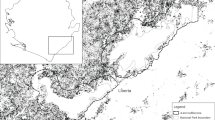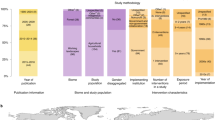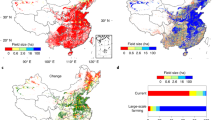Abstract
This paper examines the socio-economic implications of scaling back China’s Sloping Land Conversion Programme (SLCP), one of the world’s largest payments for ecosystem services programmes. Using the consolidation phase of SLCP as a natural experiment, a staggered difference-in-differences design is applied to a panel of rural villages (and households) located in poor and ecologically fragile areas. SLCP consolidation, consisting of a 50% subsidy reduction and suspension of a job training programme, leads to larger income declines in treated villages driven by a reduction in the likelihood that SLCP households transition from farm to non-farm work. These harmful socio-economic effects disappear, however, in villages with stronger land rights and more job training prior to consolidation. When these favourable site-specific characteristics exist, SLCP households remain equally engaged in off-farm work even after subsidy payments and training resources are scaled back. Moreover, on aggregate, village income losses are no longer detectable. The findings provide partial support in favour of the behavioural permanence thesis, highlighting the important role of prevailing local characteristics in mitigating harmful development effects otherwise brought about by programme roll-back.
This is a preview of subscription content, access via your institution
Access options
Access Nature and 54 other Nature Portfolio journals
Get Nature+, our best-value online-access subscription
$29.99 / 30 days
cancel any time
Subscribe to this journal
Receive 12 digital issues and online access to articles
$119.00 per year
only $9.92 per issue
Buy this article
- Purchase on Springer Link
- Instant access to full article PDF
Prices may be subject to local taxes which are calculated during checkout





Similar content being viewed by others
Data availability
The de-identified village- and household-level CHVES data were purchased from China’s NBS and made available to the author by the Institute on Ethnology and Anthropology at the IEA-CASS under a data use agreement that prohibits any public sharing of the data. The CHVES data are available from the author upon reasonable request and permission of IEA-CASS.
Code availability
The code for all analyses in this study can be found at https://github.com/AntJam-Howell/SLCP_Consolidation.
References
Pagiola, S., Arcenas, A. & Platais, G. Can payments for environmental services help reduce poverty? An exploration of the issues and the evidence to date from Latin America. World Dev. 33, 237–253 (2005).
Wunder, S., Engel, S. & Pagiola, S. Taking stock: a comparative analysis of payments for environmental services programs in developed and developing countries. Ecol. Econ. 65, 834–852 (2008).
Salzman, J., Bennett, G., Carroll, N., Goldstein, A. & Jenkins, M. The global status and trends of payments for ecosystem services. Nat. Sustain. 1, 136–144 (2018).
Cao, S., Zhong, B., Yue, H., Zeng, H. & Zeng, J. Development and testing of a sustainable environmental restoration policy on eradicating the poverty trap in China’s Changting County. Proc. Natl Acad. Sci. U. S. A. 106, 10712–10716 (2009).
Tallis, H., Kareiva, P., Marvier, M. & Chang, A. An ecosystem services framework to support both practical conservation and economic development. Proc. Natl Acad. Sci. U. S. A. 105, 9457–9464 (2008).
Burivalova, Z. & Gaworecki, M. Cash for conservation: do payments for ecosystem services work?Mongabay News (2017). https://news.mongabay.com/2017/10/cash-for-conservation-do-payments-for-ecosystem-services-work/
Ferraro, P. J. & Hanauer, M. M. Advances in measuring the environmental and social impacts of environmental programs. Annu. Rev. Environ. Resour. 39, 495–517 (2014).
Börner, J. et al. The effectiveness of payments for environmental services. World Dev. 96, 359–374 (2017).
Kerr, J. M., Lapinski, M. K., Liu, R. W. & Zhao, J. Long-term effects of payments for environmental services: combining insights from communication and economics. Sustainability 9, 1627 (2017).
Alix-Garcia, J. M., Sims, K. & Phaneuf, D. J. et al. Using referenda to improve targeting and decrease costs of conditional cash transfers. J. Public Econ. 176, 179–194 (2019).
Liu, J., Li, S., Ouyang, Z., Tam, C. & Chen, X. Ecological and socioeconomic effects of China’s policies for ecosystem services. Proc. Natl Acad. Sci. U. S. A. 105, 9477–9482 (2008).
Yin, R., Liu, C., Zhao, M., Yao, S. & Liu, H. The implementation and impacts of China’s largest payment for ecosystem services program as revealed by longitudinal household data. Land Use Policy 40, 45–55 (2014).
Uchida, E., Xu, J., Xu, Z. & Rozelle, S. Are the poor benefiting from China’s land conservation program? Environ. Dev. Econ. 12, 593–620 (2007).
Lin, Y. & Yao, S. Impact of the sloping land conversion program on rural household income: an integrated estimation. Land Use Policy 40, 56–63 (2014).
Uchida, E., Rozelle, S. & Xu, J. Conservation payments, liquidity constraints, and off-farm labor: impact of the Grain-for-Green program on rural households in China. Am. J. Agric. Econ. 91, 70–86 (2009).
Groom, B., Grosjean, P., Kontoleon, A., Swanson, T. & Zhang, S. Relaxing rural constraints: a ‘win–win’ policy for poverty and environment in China? Oxf. Econ. Pap. 62, 132–156 (2010).
Kelly, P. & Huo, X. Land retirement and nonfarm labor market participation: an analysis of China’s sloping land conversion program. World Dev. 48, 156–169 (2013).
Li, J., Feldman, M. W., Li, S. & Daily, G. C. Rural household income and inequality under the sloping land conversion program in western China. Proc. Natl Acad. Sci. U. S. A. 108, 7721–7726 (2011).
Delang, C. O. & Yuan, Z. China’s Grain for Green Program (Springer, 2015).
Cao, S., Xu, C., Chen, L. & Wang, X. Attitudes of farmers in China’s northern Shaanxi Province towards the land-use changes required under the Grain for Green project, and implications for the project’s success. Land Use Policy 26, 1182–1194 (2009).
Yu, X. Central–local conflicts in China’s environmental policy implementation: the case of the Sloping Land Conversion Program. Nat. Hazards 84, 77–96 (2016).
Keane, A. et al. Impact of Tanzania’s wildlife management areas on household wealth. Nat. Sustain. 3, 226–233 (2020).
Gustafsson, B. A., Hasmath, R. & Ding, S. Ethnicity and Inequality in China (Routledge, 2020).
Deng, X., Wang, Z. & Zhao, C. Economic evolution in China’s ecologically fragile regions. J. Econ. Surv. 30, 552–576 (2016).
Wunder, S. et al. From principles to practice in paying for nature’s services. Nat. Sustain. 1, 145–150 (2018).
Pagiola, S., Honey-Rosés, J. & Freire-González, J. Evaluation of the permanence of land use change induced by payments for environmental services in Quindio, Colombia. PLoS ONE 11(3): e0147829. (2016).
Grosjean, P. & Kontoleon, A. How sustainable are sustainable development programs? The case of the Sloping Land Conversion Program in China. World Dev. 37, 268–285 (2009).
Administration, S. F. Report for Monitoring and Assessment of the Socioeconomic Impacts of China’s Key Forestry Programs (State Forestry Administration, 2013).
National Bureau of Statistics of China. China Rural Statistical Yearbook (China Statistics Press, 2012).
Athey, S. & Imbens, G. W. Design-Based Analysis in Difference-in-Differences Settings with Staggered Adoption, Working Paper No. 249631-38 (NBER, 2018).
Callaway, B. & Sant’Anna, P. H. Difference-in-Differences with Multiple Time Periods, Working Paper No. 3148250 (SSRN, 2019).
Acknowledgements
The author would like to thank all of the members of the CHVES team as well as colleagues at the School of Public Affairs at ASU for support and feedback during preparation of this manuscript. Any remaining errors are the author's own.
Author information
Authors and Affiliations
Corresponding author
Ethics declarations
Competing interests
The authors declare no competing interests.
Peer review
Peer review information
Nature Human Behaviour thanks Minjuan Zhao and the other, anonymous, reviewer(s) for their contribution to the peer review of this work.
Additional information
Publisher’s note Springer Nature remains neutral with regard to jurisdictional claims in published maps and institutional affiliations.
Supplementary information
Supplementary information
Supplementary discussion, figures and tables
Rights and permissions
About this article
Cite this article
Howell, A. Socio-economic impacts of scaling back a massive payments for ecosystem services programme in China. Nat Hum Behav 6, 1218–1225 (2022). https://doi.org/10.1038/s41562-022-01401-y
Received:
Accepted:
Published:
Issue Date:
DOI: https://doi.org/10.1038/s41562-022-01401-y



